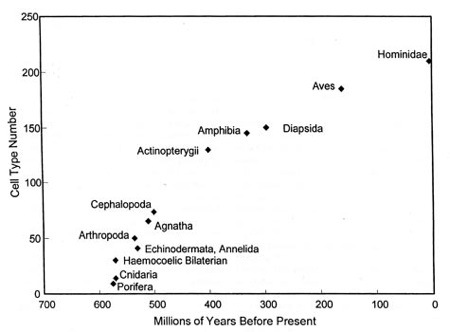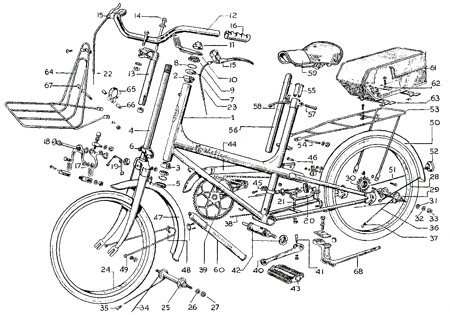Increasing Specialization
Evolution moves from the general to the specific. The first version of the cell was a general purpose survival machine. Over time evolution honed that one generality into multiple specialties. In the beginning the domain of life was restricted to warm ponds. But most of the planet was far more extreme; volcanoes and glaciers. Evolution devised cells that specialized in living in boiling hot water, or within freezing ice, or special cells that could eat oil, or trap heavy metals, or glow in the dark. Specialization enabled life to colonize these major, but varied, extreme habitats, and also to fill millions of niche environments – such as the insides of other organisms, or on the dimples of dust particles in the air. Very soon every possible environment on the planet sprouted a specialized variety of life making a living there. Presently there are no sterilized places anywhere on the planet that we’ve inspected, except in a very few temporary spots within a hospital setting. The cells of life keep specializing.
The trend toward specialization holds for multicellular organisms as well. Cells within an organism specialize. The human body has 210 different types of cells, including the specialized cells in your liver, and a different type for your kidneys. You have special heart muscle cells, different from ordinary skeletal muscle cells. The original omnipotent egg cell that initiates every animal divides into cells with greater specificity, until after less than 50 mitotic cell divisions you and I wind up with a unified assemblage of 10^15 bone cells, skins cells and brain cells.
Over evolutionary time, there is a significant rise in the number of cell types in the most complex organism. In fact, these organisms are more complex in part because they contain more specialized parts. So specialization follows the arc of complexity.

The number of cell types found in organisms over evolutionary time.
The organism itself also tends toward great specialization. Over the course of time, for one example, barnacles (comprised of 50 specialty cell types) evolve into specialty barnacles: the Six-plated Barnacle specializes in extreme high-tide locations that are flooded (with food to eat) only several times a month. Or, the Sacculina Barnacle that grows only inside the egg sack of a living crab. Birds focus into specialized type of seed eaters with specialized beaks: fine ones for small seeds, but fat beaks for hard seeds. A few plants are opportunistic (we call them weeds) occupying any disturbed soil, but most plants dedicate their survival skills toward a particular niche: dark tropical swamps, or dry, windy alpine mountain peaks. Koala bears are famously specialized on eucalyptus trees, and pandas on bamboo. Parasiticism is particularly specific and yet so common in life that some experts estimate up to 50% of living species are parasites. Most parasites, such as lice, will feed only on one species, and often only on one bodily part of one species. There are parasites that prey only on other special parasites.
The trend toward specialization in life is propelled by an arms-race. More specialized organisms (such as a clam feeding in sulfuric emissions in lightless deep sea vents) present more specialized environments for competitors and prey (crabs that feed on them), which breed more specialized strategies (parasites on the crabs), and solutions, and in the end yet more specialized organisms.

This urge to specialize extends into the technium. The original tool of the hominids, a roundish rock with a broken edge, was a general purpose tool used for scrapping, cutting, and hammering. Once taken up by Sapiens, the general tool morphed into specialty tools: a separate scraper, cutter, or hammer. The variety of tool species increased over time as specialty tasks increased. Sewing required needles; sewing hide required special needles, sewing woven fabric another. When simple tools were recombined into composite tools (string + stick = bow) specialization increased further. The astounding diversity of manufactured items today is primarily driven by the need for specialized parts of complicated devices.

At the same time, just as in organic life, tools tend to start out useful for many things and evolve toward specific tasks. The first camera with photographic film was invented in 1885. Once incarnated, the idea of the camera started to specialize. Within years of its birth inventors devised tiny spy camera, extra large panoramic cameras, compound lens cameras, high-speed flash cameras. Today there are hundreds of specialty cameras, including those for use deep underwater, to cameras designed for the vacuum of space, or those to capture the infrared, or the ultraviolet. There are telephoto cameras for the very far and microscopic cameras for the very close. While one can still purchase (or make) the original general purpose camera, they count for an increasing smaller proportion of cameradom.
This sequence from general to specific holds true for most technologies. Automobiles start off broadly appealing and over time, they evolve to specific models, while the general purpose variety fades. In cars you choose among compacts, SUVs, vans, sporty models, sedans, pickups, hybrids, and so on. Scissors are specified for hair, paper, carpet, mesh, or flowers.
As we look into the future, specialization will continue to increase. The first gene sequencer sequenced any gene. The next step is a specialized human DNA sequencer, which only does humans or another species, say the mouse for researchers. Then we’ll see sequencers that specialize in racial genomes (for African-Americans or Chinese), or extremely portable ones, or ones that are extremely fast and sequence in real time, letting a person know whether pollutions are damaging their genes right now. The first commercial virtual reality consoles will serve up virtual realities for all purposes, but over time, VR consoles will evolve special versions with special gear for games, or military practice, or movie rehearsals, or shopping.
At the moment computers seem to be headed in the opposite direction. They seem to becoming evermore general purpose machines, as they swallow more and more functions. Entire occupations and their worker’s tool have been subsumed by the contraptions of computation and networks. Computers have already absorbed calculators, spreadsheets, typewriters, film, telegrams, telephones, walkie talkies, compasses and sextants, television, radio, turntables, draft tables, mixing boards, war games, music studios, type foundries, flight simulators, and many other vocational instruments. You can longer tell what a person does by looking at their workplace because they all look the same: a personal computer. Ninety percent of employees are using the same tool. Is that the desk of the CEO, the accountant, the designer, or the receptionist? This convergence is amplified by cloud computing, where the actual work is done on the net as a whole, and the tool at hand merely becomes a portal to the work. All portals become the simplest possible window: a flat screen of some size.
This convergence is temporary. We are still in the early stages of computerization – or rather intelligenation. Everywhere we currently apply our own personal intelligence (in other words, everywhere we work and play) we are rapidly applying artificial and collective intelligence as well, and rapidly overhauling our tools and expectations. We’ve intelligenized bookkeeping, photography, financial trading, metal machining, airplane piloting, among thousands of other tasks. We are about to computerize automobile driving, medical diagnosis, and speech understanding. In our rush toward large-scale intelligenation, we first installed the general purpose PC with its mass-produced small brain, mid-size screen, and conduit to the net. So all chores get the same tool. To complete the dispersion of intelligenation into all occupations will probably require another decade. Silly as it now sounds, we will put artificial intelligence into hammers, dental picks, fork lifts, stethoscopes, and frying pans. All these tools will gain new powers by sharing the universal intelligence of the network. But as their newly augmented roles become clear, the tools will specialize. We can see the first glimmers in the iPhone, Kindle, Wii, and netbooks. As display and battery technology catches up to chips, the interface to ubiquitous intelligenation will diverge and specialized. Soldiers and other athletes who use their full body want large-scale enveloping screens, while mobile road warriors want small ones. Gamers want minimal latency, readers want maximum legibility, hikers want waterproofing, kids want indestructibility. The portals into computation, or the net, will specialize to a remarkable degree. The keyboard, for one, will loose its monopoly. Speech and gesture input will gain a major role. Spectacle and eyeball screens will supplement walls and flexible surfaces.
When we pick up a smart hammer, the handle will contain its smartness. A very smart air hammer pounds in nails at the right speed, of the correct type, for that immediate material and job. Computational intelligence will mostly disappear into the tool itself, so we only deal with the interface. The interface for tools will specialize as the jobs specialize. The ultimate specific technology or technique is customized to a particular use by a specific user for a specific time. Very niche-y functions may summon devices that are assembled for only that task and then unassembled. Ultra-specialized artifacts may live for only a day like a mayfly. Specialization may be reckoned in half-lives.
All the things we make with our mind, and the creations of artificial minds, will all tend over time to become more niche based. The “long-tail” is not merely a characteristic of media, but of technological evolution itself: the tail of niches gets longer and longer. We can imagine the future of almost any invention working today by imagining it evolving into dozens of narrow uses. Technology is born in generality and grows to specificity. Technology wants specialization.


